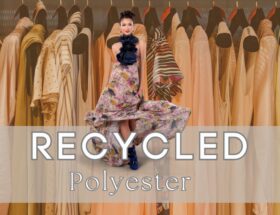Fast fashion and its irresistible appeal, it’s something many of us can’t deny. But have you ever taken a moment to ponder over the environmental tab that comes with it? Just like you, I’ve found myself questioning how our insatiable craving for the latest trends is impacting Mother Earth.
In this article, we’re going to discover the not-so-stylish truth behind fast fashion— from gauging greenhouse gas emissions to investigating sustainability claims. So settle in; we’re about to peel back the layers on your go-to shopping haven!
The short answer to the question, can fast fashion be sustainable? is, Yes, fast fashion can be sustainable if fashion brands adopt more sustainable practices and prioritize the social and environmental impact of their operations. This includes considering the environmental damage caused by the fashion industry’s carbon emissions, wastewater, and impact on biodiversity, as well as ensuring fair treatment of workers and promoting sustainable development.
The roadblock is the ‘IF” in the answer above.
Keep reading and let’s find out what it would take and why it matters
Quick and Easy Navigation
The Environmental Cost of Fast Fashion
Fast fashion’s environmental cost is frighteningly high. Water consumption in the industry is massive, exacerbating global water scarcity issues. It doesn’t stop at consumption either; fashion production also leads to severe water pollution.
Pesticides used in cotton farming infiltrate our soil and waters, harming wildlife and human health alike. And let’s talk about waste – we’re facing significant challenges when it comes to recycling these quick trend pieces that end their lives languishing in landfills far too often.
Water consumption and pollution
Fast fashion drinks up a lot of water. Making one pair of jeans uses 2,000 gallons! It’s a big deal because many people don’t have enough clean water. Fast fashion also muddies the waters.
Dyes and chemicals used in making clothes get into rivers, lakes, and oceans. This is bad for the fish and plants living there.
Pesticide use
Fast fashion needs a lot of cotton. This demands much pesticide use. Toxic chemicals from these pesticides harm our land and water. These are not good for the health of people around it too.
Sustainable fashion wants to reduce pesticide pollution. But, fast fashion makes this hard to do. The use of so many harmful chemicals can make it tough for the industry to be truly sustainable.
More safe ways need to be found if we are serious about protecting our environment.
Recycling challenges
Recycling clothes is not easy in the fast fashion world. Few pieces can turn into new ones. The fact is, less than one percent of old garments become new clothes! That’s a big problem for our planet.
Some brands only use four percent of recycled fabrics too. They make most clothes from new materials like polyester and cotton. These items often end up in landfills or pollute our oceans with plastic-based yarns when they’re thrown away.
We need to change this and make recycling a key part of making clothes.
Challenges in Making Fast Fashion Sustainable
The fast fashion model is inherently unsustainable. It thrives on overconsumption and often resorts to greenwashing, which distorts the reality of its environmental impact.
Inherently unsustainable business model
Fast fashion is bad for our planet. The business model aims to make and sell clothes fast. This leads to a lot of waste and harms the environment. It uses too many resources like water, energy, and materials.
These are big reasons why fast fashion is not sustainable. We need to change how we make and buy clothes if we want to help our planet.
Overconsumption
People always want new clothes. They buy more and more, even when they don’t need them. This is called overconsumption. It’s a big problem for the environment and the sustainable fashion movement.
Fast fashion feeds this problem. Brands put out new styles all the time to keep up with trends. This makes people want to buy more and it causes a lot of waste. These brands have cheap prices too which make it easy for people to buy lots of clothes without thinking about how it hurts our planet.
Greenwashing and hijacking conversations
Fast fashion brands are fooling us. They use fancy words like “sustainable”, “eco-friendly” and “green”. But, it’s not true! They just want to hide the harm they do to our planet. This trick is called greenwashing.
It makes us feel good when we buy their clothes. We think we are helping the earth by choosing these so-called green items. But in reality, our shopping habits are still causing damage.
The worst part? These fast fashion companies are getting rich off this lie! They’re making loads of money while misleading people who truly care about the environment.
Potential Solutions

Explore the possibilities of alternative materials, supply chain transparency, and new technology in mitigating the environmental impact of fast fashion. Intrigued? Read on for more insights!
Alternative materials
There are good ways to fight the harm of fast fashion. One big way is using different materials to make clothes. Here are some:
- Bio-based materials: This stuff comes from plants and animals. They can help lessen the harm of fast fashion.
- Sustainable farming: Clothes can be made from things grown in a kind way to Earth. These things use less water, land, and other resources than regular farming.
- Natural fabrics: Cotton and linen fall into this group. If these clothes end up in the trash, they break down quickly.
- Less synthetic fabrics: Fast fashion loves cheap stuff like polyester. But it’s bad for the Earth because it takes too long to break down if thrown away.
Supply chain transparency
Supply chain transparency is a big deal in fast fashion. It means showing where clothes come from and how they are made. This can help us know if the clothes we buy harm the world or not.
Many fashion brands are working on this issue now. They want to do better at showing you what happens before their clothes reach stores. Still, there is work to be done. Brands need to make sure they don’t hurt people or nature while making clothes.
This way, shoppers can feel good about what they wear!
New technology
New tech is changing the fast fashion game. Tools like RFID tags and AI are cutting down waste. These tools help us keep track of items and make smart choices about what to make next.
Some other cool tech stuff includes biotech textiles and predictive analytics. They help use resources better, improve work spots, and switch to green materials. We also have new ways of making clothes with machines that cause less harm to Earth! Virtual reality lets you try on outfits without having them made first, which means fewer unwanted clothes ending up in landfills.
Tech can really play a big part in making our love for fashion kinder to our planet!
Can Fast Fashion Ever Be Truly Sustainable?
The question of whether fast fashion can ever truly be sustainable is a complex one, fraught with numerous factors to consider and reasons for skepticism.
Factors to consider
There are several things to take into account.
- The impact on the earth: Fast fashion gives off 10 percent of all greenhouse gasses caused by humans. It also creates 20 percent of the world’s waste.
- The low prices: To keep costs down, fast fashion often cuts corners. This can lead to harm to our earth and people.
- High demand: People always want more and better clothes at a lower price. This pushes brands to make many clothes quickly, not caring about how it hurts the earth or people.
- Hard to change: Brands in fast fashion make clothes quickly. This makes it hard to change so they can be good for people and the earth.
- Rise of slow fashion: More and more, people want clothes made in ways that care for our earth and people too.
Reasons for skepticism
Fast fashion is a big problem. It hurts our planet in many ways. But some people do not think fast fashion can turn green. They have good reasons to doubt.
First, fast fashion needs a lot of new clothes all the time. This makes it hard for brands to be kind to our planet. Also, most cheap clothes are made from plastic-like polyester which is bad for Earth and takes too long to get rid of.
Second, even when brands say they are ‘green’, it’s often not true. They may say they recycle or use less water but this is only a small part of what they do. Many times, their main work still harms nature a lot.
Last, some folks worry about fair pay in the clothing business which ties into sustainability too! Workers need fair wages and safe places to work if we want an industry that looks after both people and Planet Earth.
Steps Towards a More Sustainable Fashion Industry
We can contribute to a more sustainable fashion industry by sharing our purchase stories, advocating for fair fashion practices and pushing brands towards greater sustainability.
Join the fair fashion movement
We all have a role to play in changing the fashion world! Let’s start by joining the fair fashion movement. It stands for clothing made with care for both people and our planet. We can choose clothes from brands that treat their workers well.
These brands also don’t harm nature when making their clothes. If we buy less, but better, we help make fashion kinder to our world. And remember, even small changes count!
Encouraging brands to be more sustainable
Making brands more sustainable is a task we all can help with. Here’s how:
- Let brands know your thoughts. Write to them or use social media. Tell them you want items that don’t harm the earth.
- Buy fewer clothes but pick better ones. Choose clothes that last long and are made well.
- Support brands that have good practices. Some brands work hard to limit their harm on the earth.
- Recycle and upcycle clothes when you can. Turn old clothes into new ones, or give them away for reuse.
- Teach others about this issue too! The more people who care, the more change we can make.
- Be ready to spend a bit more for quality items which last longer, rather than buying cheap clothes often.
- Find out how clothes are made before buying them, and choose those with less harmful ways of creation.
- Don’t be fooled by “greenwashing”. Some brands claim to be green but really aren’t!
- Help create rules for fashion companies to follow so they cause less harm to our earth.
Conclusion
Fast fashion faces a big task. It needs to change to help our planet. We all need to know this and play our part too. Only then can we hope for a more green, fair future in fashion.
Fast Fashion Road to Sustainability FAQ
Q: What is the environmental impact of fast fashion?
A: The environmental impact of fast fashion is significant, including carbon emissions, wastewater, and biodiversity loss. The ultra-fast fashion giants often contribute to these issues through their production processes and reliance on non-renewable resources.
Q: How can fashion brands be made sustainable?
A: Fashion brands can be made sustainable by adopting more eco-friendly materials, such as organic cotton and biodegradable fabrics, reducing waste through a circular fashion model, and ensuring fair wages for workers while promoting ethical and sustainable practices throughout the supply chain.
Q: What is circular fashion?
A: Circular fashion refers to a new business model that aims to reduce waste and promote sustainability within the fashion industry. It involves designing garments with the intention of recycling or repurposing them at the end of their life cycle to make new clothing or other products, thus minimizing environmental impact.
Q: What are some examples of fashion brands adopting sustainable practices?
A: Patagonia and H&M are examples of fashion brands that have taken steps to become more sustainable. Patagonia focuses on using recycled materials and promoting fair labor practices, while H&M has committed to using more sustainable materials and reducing its environmental impact.
Q: How can the fashion industry become more sustainable?
A: The fashion industry can become more sustainable by reducing carbon emissions, promoting fair labor practices, adopting more sustainable materials, implementing a circular economy approach, and prioritizing the social and environmental impact of their operations.
Q: What are ESG criteria in the context of the fashion industry?
A: ESG criteria, which stands for Environmental, Social, and Governance, are used to evaluate the sustainability and ethical impact of investments, including those in the fashion industry. It assesses factors such as a brand’s environmental footprint, treatment of workers, and ethical business practices.
Q: What is the impact of “fast fashion” on the environment?
A: The impact of “fast fashion” on the environment includes contributing to carbon emissions, water pollution, waste generation, and depletion of natural resources. This can result in long-term environmental damage if not addressed by fashion retailers and the industry as a whole.
Q: How can fashion brands reduce their environmental impact?
A: Fashion brands can reduce their environmental impact by using sustainable materials, minimizing waste through a circular fashion model, reducing carbon emissions, and ensuring ethical and fair treatment of workers throughout the supply chain.









